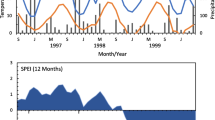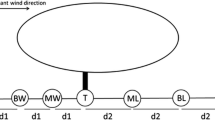Abstract
We measured newly-produced seeds entering the soil (Potential Seed Bank) to assess the timing and spatial patterning of Phase I dispersal in the central Monte desert, Argentina. Rates of forb- (6.13 mg m-2 d-1) and shrub-seed input (48.9 mg m-2 d-1) were maximum in early summer. The rate of grass-seed input, instead, was similar in early and late summer (7 to 8 mg m-2 d-1). About 90% of forb- and shrub-seed mass entered the habitat through protected (i.e., under canopy) areas, whereas 70% of grass-seed mass did so through exposed areas. Adult plant location and the uneven impact of wind on shrub, forb and grass seeds may explain such patterns.
We also compared the Potential Seed Bank with the soil seed bank in the following spring (Realized Seed Bank). Seeds that form transient banks in other ecosystems (e.g., shrub seeds of the genus Larrea, or perennial grass seeds like those of Pappophorum and Trichloris) prevailed in the Potential Seed Bank. Some annual forb seeds, instead, appeared to form a more persistent seed bank, and prevailed in the Realized Seed Bank (e.g., Chenopodium). Horizontal redistribution did not affect the spatial patterning of forb and shrub seeds, but produced a more homogeneous distribution of grass seeds in the habitat. The impact of wind could explain the redistribution pattern of grass seeds. Finally, we found almost 80% of total seeds in the top 2 cm of soil. The smallest grass and forb seeds (Sporobolus and Descurainia) as well as some medium-sized and large forb seeds (e.g., Glandularia, Sphaeralcea, Phacelia) were able to reach deeper soil layers in the central Monte desert.
Similar content being viewed by others
References
Aguiar, M. R. & Sala, O. E. 1997. Seed distribution constrains the dynamics of the Patagonian steppe. Ecology 78: 93-100.
Cavagnaro, J. B. 1988. Distribution of C3 and C4 grasses in a temperate arid region of Argentina. Oecologia 76: 273-277.
Chambers, J. C & MacMahon, J. A. 1994. A day in the life of a seed: movements and fates of seeds and their implications for natural and managed systems. Annu. Rev. Ecol. Syst. 25: 263-292.
Childs, S. & Goodall, D. W. 1973. Seeds reserves of desert soils. US/IBP Desert Biome Research Memorandum 73-75.
Grime, J. P. 1989. Seed banks in ecological perspective. In: Leck, M. A., Parker, V. T. & Simpson, R. L. (eds), Ecology of Soil Seed Banks. Academic Press, New York, USA.
Harper, J. L. 1977. Population biology of plants. Academic Press, New York, USA.
Jaksic, F. M. & Fuentes, E. 1980. Why are native herbs in the Chilean matorral more abundant beneath bushes: microclimate or grazing? J. Ecol. 68: 665-669.
Kelrick, M. I. 1991. Factors affecting seeds in a sagebrush-steppe ecosystem and implications for the dispersion of an annual plant species, cheatgrass (Bromus tectorumL.). Dissertation, Utah State University, Logan, Utah.
Kemp, P. R. 1989. Seed bank and vegetation processes in deserts. In: Leck, M. A., Parker, V. T. & Simpson, R. L. (eds), Ecology of Soil Seed Banks. Academic Press, New York, USA.
Lopez de Casenave, J., Cueto, V. R. & Marone, L. 1998. Granivory in the Monte desert: is it less intense than in other arid zones of the world? Global Ecology and Biogeography Letters 7: (in press).
Louda, S. M. 1989. Predation in the dynamics of seed regeneration. In: Leck, M. A., Parker, V. T. & Simpson, R. L. (eds), Ecology of Soil Seed Banks. Academic Press, New York, USA.
Louda, S. M., Potvin, M. A. & Collinge, S. K. 1992. Predispersal seed predation in the limitation of native thistle. In: Menken, S. B. J., Visser, J. H. & Harrewijn, P. (eds), Insect-Plant Relationships. Kluwer Academic Publishers, Dordrecht, The Netherlands.
Marone, L. 1990. Modifications of local and regional bird diversity after a fire in the Monte Desert, Argentina. Revista Chilena de Historia Natural 63: 187-195.
Marone, L. 1991. Habitat features affecting bird species distribution in the Monte desert, Argentina. Ecología Austral (Argentina) 1: 77-86.
Marone, L. & Horno, M. E. 1997. Seed reserves in the central Monte desert, Argentina: implications for granivory. J. Arid Environ. 36: 661-670.
Marone, L., Rossi, B. E. & J. Lopez de Casenave 1998. Granivore impact on soil-seed reserves in the central Monte desert, Argentina. Funct. Ecology 14 (in press).
Mull, J. F. & MacMahon, J. A. 1996. Factors determining the spatial variability of seed densities in a shrub-steppe ecosystem: the role of harvester ants. J. Arid Environ. 32: 181-192.
Nelson, J. F. & Chew, R. M. 1977. Factors affecting seed reserves in the soil of a Mojave Desert ecosystem, Rock Valley, Nye County, Nevada. Am. Midl. Nat. 97: 300-320.
O'Connor, T. G. & Pickett, G. A. 1992. The influence of grazing on seed production and seed banks of some African savanna grasslands. J. Appl. Ecol. 29: 247-260.
Price, M. V. & Joyner, J. 1997. Characterizing resource availability: seed production and standing crop in the Mojave desert. Ecology 78: 764-773.
Pulliam, H. R. & Brand, M. R. 1975. The production and utilization of seeds in plain grasslands of southeastern Arizona. Ecology 56: 1158-1166.
Reichman, O. J. 1975. Relation of desert rodent diets to available resources. J. Mammal. 56: 731-749.
Reichman, O. J. 1984. Spatial and temporal variation of seed distributions in Sonoran Desert soils. J. Biogeogr. 11: 1-11.
Roberts, H. A. 1981. Seed banks in soils. Adv. Appl. Biol. 6: 1-55.
Soriano, A. & Sala, O. E. 1986. Emergence and survival of Bromus setifoliusseedlings in different microsites of a Patagonian arid steppe. Israel J. Bot. 35: 91-100.
Turner, F. B. 1973. Rock Valley Validation Site report. US/IBP Desert Biome Research Memorandum 73-2.
Willson, M. F. 1992. The ecology of seed dispersal. In: Fenner, M. (ed), The ecology of regeneration in plant communities. Wallingford, UK: CAB.
Zar, J. H. 1984. Biostatistical analysis. Second Edition. Prentice-Hall Inc., New Jersey.
Author information
Authors and Affiliations
Rights and permissions
About this article
Cite this article
Marone, L., Rossi, B.E. & Horno, M.E. Timing and spatial patterning of seed dispersal and redistribution in a South American warm desert. Plant Ecology 137, 143–150 (1998). https://doi.org/10.1023/A:1009776601012
Issue Date:
DOI: https://doi.org/10.1023/A:1009776601012




